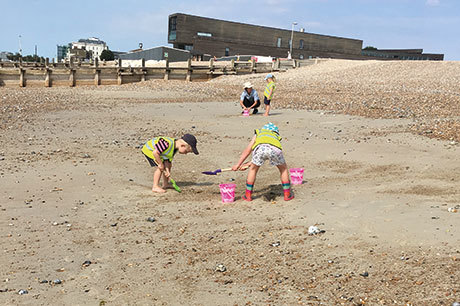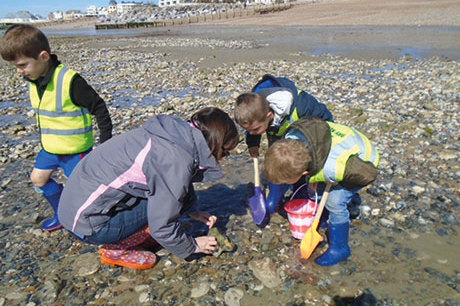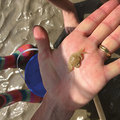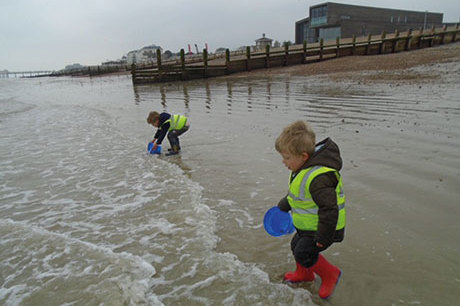
Download the PDF of this article
Worthing Beach in West Sussex is a stone’s throw from Davison Day Nursery, where eight children aged between three and five years set off each week for a beach school session.
‘The beauty of being on the beach is that it’s a forever-changing environment that differs each day, depending on whether the tide is in or out or if the weather is hot or cold,’ explains Heather Apsey, SENCo and Level 3 qualified beach school practitioner.
‘If it’s been particularly windy, the children enjoy searching for stimulating natural resources deposited on the beach, like seaweed and drift wood. They also like to build dams with the pebbles and streams created by the outgoing tide. It’s the ideal environment to implement in-the-moment planning, which fits into our nursery ethos.’
LOCAL ENVIRONMENT

Scavenger hunts, building sandcastles, rockpooling, making beach fires and beach art are just some examples of activities that children get to take part in on this long, clean stretch of beach in the vibrant town of Worthing. But sometimes the children are content to just listen to the sounds of the rolling waves in the distance, of jet skis or the seagulls overhead.
‘They also like to watch the coastguards on their quad bikes,’ adds Ms Apsey. ‘It’s not something they see every day and it helps them develop a sense of their environment.’
The journey to the beach also promotes children’s awareness of their local community. Walking in pairs and accompanied by Ms Apsey and two nursery practitioners, they notice familiar landmarks and house numbers, they listen to the sounds in the immediate environment and they discuss road safety as they cross the busy road to the Promenade. They also talk about what they might find at the beach, such as crabs, shells, boats and seagulls.
‘Once on the beach,’ explains Ms Apsey, ‘we choose a spot for our pop-up tent, which provides shelter in all weathers. The children have access to a variety of equipment such as different-size buckets, spades, containers and identification charts. There are no set boundaries, but children wear high-visibility waistcoats and staff help to guide and support their play and learning by listening to their interests and following their lead.’
SUPPORTING DEVELOPMENT
Beach school provides an ‘enabling environment’ for children to learn, explore and have fun both through planned and natural exploration, and opens up opportunities to explore all areas of the EYFS.
Here are some examples of the activities that the children take part in at beach school and how it has impacted their learning:
Rockpooling

Children love hunting for creatures in the rock pools. They find crabs, fish, lugworms and sea anemones, and they place them in clear buckets, study and identify them and then release them gently back into their natural habitat. They learn that creatures living in rockpools need to adapt to the water being heated by sunlight and diluted by rainwater, as well as to the water levels dropping.
Climbing over the rocks in wellies or rock shoes is also a great physical act, which cannot be replicated through equipment in the playground. It helps the younger children to gain a deeper understanding of how their bodies work and gives them confidence through risk-taking.
Imaginary play
During one visit to the beach, a line of shallow trenches had been dug in a rectangle shape with several trenches built in the middle. This captured the children’s interests and it sparked spontaneous imaginary play. The area around the trenches became an island. One child took it upon himself to become the leader and instructed the help of others to carry on digging shallow trenches, some of which headed off to the sea and some up towards the tent.
They created dams using stones and pebbles and collected pieces of driftwood and shells for decoration of houses on the island. There was a sense of purpose and urgency as everyone worked towards the same goal. This activity promoted working together, communicating with each other and demonstrating individual interests.
Mathematical development
There are many opportunities to explore number, shape and size through activities that occur naturally on the beach. When collecting shells and pebbles, some children enjoy grouping together similar or the same type of shells and pebbles. This then leads on to a natural opportunity to count the pebbles or shells.
 In the same way, they can also classify sea creatures (pictured right) by using the identification charts and grouping together their finds.
In the same way, they can also classify sea creatures (pictured right) by using the identification charts and grouping together their finds.
Counting the steps down to the beach and exploring the language of length and depth when paddling in the sea – they can go in up to their knees – is another activity which promotes mathematical development. Children also use positional language – up, down, behind and in front of – which develops their spatial awareness. They show an interest in shape by being immersed in a sustained construction activity – for example, building a sandcastle – or talking about shapes or arrangements of objects.
Estimations about how big they think hidden pebbles or rocks are which lie in the sand is a popular activity and they like to problem-solve ways to get out the buried pebble.
Children like to mark-make in the sand with drift wood, often writing numbers or creating a hopscotch. They also use chalk pebbles found on the beach to create numbers on the groynes or on larger pebbles on the beach.

Children from Davison Day Nursery collect water on Worthing Beach
Case study: Oliver
Four-year-old Oliver, who has a trajectory schema, thrives at the beach, as it provides him with the space and freedom to explore horizontally and vertically. He particularly enjoys digging trenches, which can be as short or as long as he desires, and he likes throwing pebbles into the sea.
Ms Apsey says, ‘Oliver uses his schema throughout his play, both within the setting and at the beach. He enjoys digging in our mud patch and in the large outdoor sandpit, and he enjoys physical activities such as obstacle courses. He particularly likes racing on the balance bike, which involves moving forward in a straight line, which is linked to his schema.
‘For him, being confined to indoors, complying to routines and being in a large group in a small space is very restrictive. We notice that his behaviour changes when he is outside, and in particular on the beach. He is able to regulate himself in a more positive way and he demonstrates positive behaviour towards others.
‘He is always keen to explore the beach environment and the activities help him to develop his own risk management, which is a key factor for Oliver.’
About the setting
- Davison Day Nursery was originally set up to provide childcare for staff at Davison CE High School for Girls. It is now open to the wider community
- It currently offers 40 full-time term-time-only places a day
- Two-hour beach school sessions started to run in spring 2015
- The setting’s outdoor area includes a custom-made sandpit, mud kitchen and a variety of textured surfaces including a grass mound, flat grassed area and all-weather surface. The children also have access to a small front garden to explore and to grow their own vegetables, flowers and herbs
- Heather Apsey holds a Level 3 beach school practitioner qualification, http://archimedes-earth.com/beach-schools









